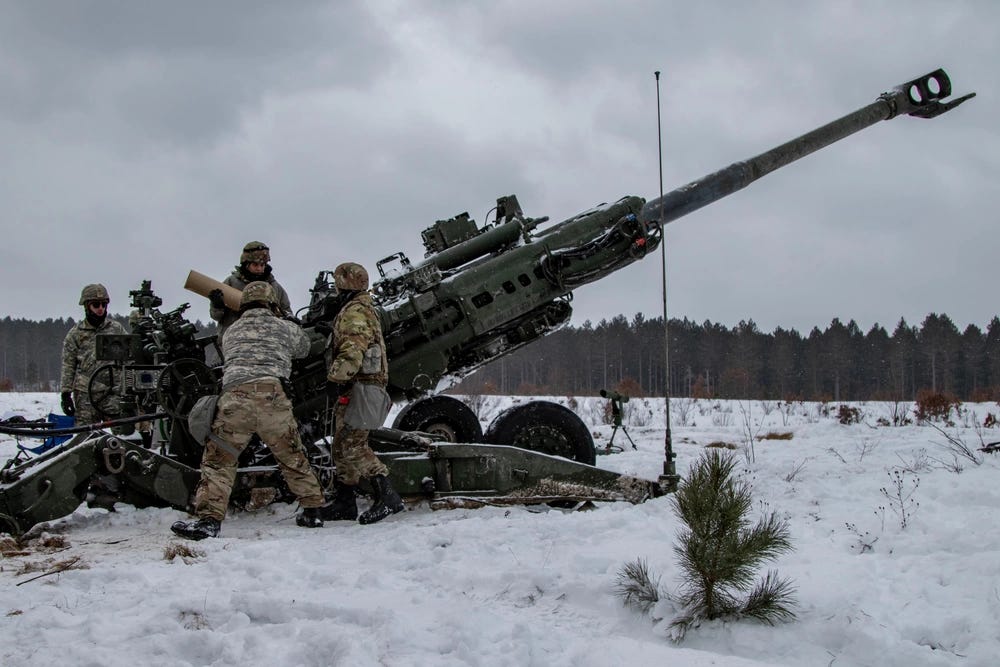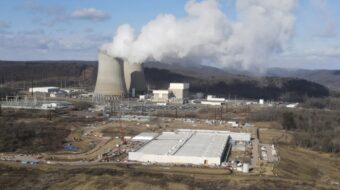
NORTHERN MICHIGAN—The Camp Grayling Joint Maneuver Training Center is the U.S. Army National Guard’s largest training site, covering roughly 231 square miles.
And for months, discussions have been going on around the expansion of Camp Grayling, a training center located on land forcibly taken from the Odawa and Ojibwa generations ago; a training center that has been exposing local residents and nearby waterways to carcinogens for years; a training center that strives to train soldiers for future American wars and provide police with urban warfare tactics to suppress those protesting injustice.
Since January 2022, northern Michigan communities, the Michigan Army National Guard, and the Michigan Department of Natural Resources have been engaged in back-and-forth debates over the Guard’s proposal to expand its land use agreement by roughly 253 square miles of DNR land.
If approved, the expansion would greatly expand a training site used not only by the Army National Guard but also by dozens of police departments, private contractors, and foreign military units.

This proposed land expansion coincides with the Air National Guard’s proposed expansion of its current 17,000 square miles of charted Special Use Airspace over the Alpena Combat Readiness Training Center.
Justifying the proposal, Camp Grayling officials told the Michigan DNR:
“The U.S. military has transitioned from training for counter insurgency to training for large-scale combat operations in response to new and emerging global threats. The resultant military readiness training now requires immersive, multi-domain exercises which integrate land, air, maritime, cyber, and space domains over greater distances than those afforded with Camp Grayling’s current size. The newly proposed training areas, if approved, would be used for periodic, low-impact activities such as drone operation, cyber, electronic warfare, space, and communication system installation and operation.”
The Michigan DNR is currently reviewing the expansion proposal, and there is no timetable for when it will announce a decision.
For years, Camp Grayling has been the site of controversy for local residents due to the pollution of nearby bodies of water with PFAS, the so-called “forever chemical.” Exposure to PFAS (or polyfluoroalkyl substances) has been linked to higher rates of certain cancers, such as prostate, kidney, and testicular cancers, decreased fertility, high blood pressure during pregnancy, developmental delays in children, and other health issues.
While the military first reported PFAS contamination at Camp Grayling in 2016, PFAS-containing firefighting foam has reportedly been used there for decades.
In the spring of 2019, over 1,100 drinking water samples were tested near Camp Grayling for PFAS contamination. Nearly 300 tested positive for some level of PFAS contamination, with 19 homes having PFAS levels at or above the EPA’s “health advisory standard for lifetime exposure—70 parts per trillion,” as reported by the Traverse City Record-Eagle. Seventeen of these houses were located near the airfield at Camp Grayling, and two houses were located near Lake Margrethe.
For those houses that reported PFAS levels at or above 70 parts per trillion, the U.S. military paid for their water sources to be rerouted. For those who were exposed to PFAS levels less than 70 ppt, they were given water filters.
“While bottled water and filters are a temporary solution, we recognize something more durable needs to happen as we go through the process,” said Lt. Col. James Crowley of the National Guard Bureau at a community meeting in Grayling in August 2019.

“Money for these types of solutions expire at a certain point,” Lt. Col. Crowley said.
The project to reroute the water supplies for Grayling Township residents was estimated to have cost between $5 million and $9 million, as reported by the Record-Eagle.
“So you’re fixing it for a few,” said a man who lived south of the Camp Grayling’s airfield and whose house reportedly had PFAS levels at 40 ppt. “Are we supposed to stay on filters forever?”
In July 2022, the Michigan Department of Environment, Great Lakes, and Energy (EGLE) sent a violation notice to the National Guard, accusing Camp Grayling of discharging PFAS-contaminated stormwater into Lake Margrethe.
As well, an official with EGLE sent a letter to the Guard last December, saying the DNR should reject the expansion proposal due to Camp Grayling’s disregard for PFAS pollution.
In a letter to Bonnie Packer, the PFAS program manager for the Army National Guard’s Cleanup and Restoration, EGLE supervisor Randall Rothe wrote that the proposed expansion should be rejected due to the Guard’s “inability to take timely action to investigate, mitigate, and remediate significant areas of contamination at Camp Grayling,” as reported by Bridge Michigan.
Often in local media reports about the expansion proposal, local residents who otherwise can’t find an unkind word to use about the U.S. military have vocally opposed the proposal due to environmental concerns.
The Board of Commissioners for Roscommon, Otsego, Crawford, and Kalkaska counties have all passed resolutions in opposition to the expansion proposal.
And shortly after the Michigan DNR ended public comment on the proposal, local lawmakers sent a letter to Gov. Gretchen Whitmer, saying their constituents’ environmental concerns should be considered in the DNR’s decision to approve or deny the expansion.
“We fully support our military and law enforcement and do not want this to be interpreted as a letter of opposition against them in any way,” reads a letter drafted by Republican State Rep. Ken Borton, and co-signed by Reps. John Roth and Cam Cavitt, as well as State Sen. John Damoose.
“It is our belief that proposed expansions have the potential to threaten the health, safety, and general welfare of the people in this region,” the letter continues.
As stated previously, Camp Grayling is a training center not only used by the U.S. military, but also by private contractors, police departments, and foreign military units.
In 2020, the Michigan National Guard established the National All-Domain Warfighting Center (NADWC), which encompasses Camp Grayling, the Alpena Combat Readiness Training Center, the Selfridge Air National Guard Base in Harrison Township (roughly 27 miles from Detroit), and the Battle Creek Air National Guard Base.
The goal of the NADWC is partially to make National Guard centers more attractive for private contractors and the Department of Defense to test new technologies.
“Ever since we unveiled NADWC, my phone has been ringing off the hook with private industry trying to get into this space,” Col. Meyers said in an interview with DBusiness Magazine in July 2022. “And the advantage is that we have a lot of availability and a lot of land for folks to come out here and play.

“The interest I have as the commander here at Grayling is to try to create an environment where you always have the latest technologies around those war-fighting functions when they’re ready,” Col. Meyers said.
The proposed expansion of Camp Grayling would allow for more space to test technologies related to electronic warfare (EW). For weapons contractors such as Raytheon, Northrupp Grumman, and Lockheed Martin, EW can refer to technologies that can jam signals and collect electronic intelligence, as well as directed energy weapons and electromagnetic weapons.
For private tech companies such as Palantir, DeDrone, Anduril, and Fog Data Sciences, EW can entail surveillance tools in the form of software, hardware, and data management solutions provided to the Department of Defense; these technologies are also provided to customers in the prison-industrial complex, commercial corporate spaces, the Department of Homeland Security, and law enforcement agencies.
The potential expansion would allow for improvements in EW technologies for law enforcement agencies to conduct surveillance on protesters, as was likely the case during the nationwide protests against police brutality in 2020, with police using stingrays and dirtboxes to track protesters’ cell phones.
These new technologies can then be tested at a training facility provided for the Northern Michigan Law Enforcement Training Group, whose membership currently stands at 75 agencies.
This training facility, called the Combined Armed Collective Training Facility, includes a mock city where officers can practice urban warfare scenarios.
The 2.25-square-kilometer mock city consists of 20 to 26 buildings (including a school, a church, a jail, stores, and houses), a tunnel/sewer system, roads, alleys, parks, athletic fields, and anything else officers might expect should they need to show up in your city. Such training facilities certainly helped the National Guard and police officers in shutting down protests in cities such as Grand Rapids and Kalamazoo in 2020 after the killing of George Floyd.

Along with providing training for law enforcement, Camp Grayling has been a training site for several foreign military units over the years, especially during the camp’s Northern Strike exercises that are held biannually in January and August.
Military units from Latvia, the United Kingdom, Canada, Denmark, Poland, Estonia, Jordan, and Bulgaria have all participated in Northern Strike exercises. These Northern Strike trainings have been said to provide “unique” training experiences, as their large scope can realistically simulate combat scenarios.
Truly, Camp Grayling is a playground fit for the most jingoistic war hawks the United States has to offer.
“We’re getting ready to go to war,” said Major General Gregory Vadnais, a Michigan National Guard commander, in an interview with MLive in 2017. “That [is] the business we’re in. It could happen tomorrow.
“North Korea could go like that,” Vadnais said, snapping his fingers.
At a time when people across the U.S. are showing solidarity with those protesting the construction of a police training facility outside of Atlanta, Ga., an equally troubling development is brewing in the forests of northern Michigan.
The proposal to more than double the size of the Army National Guard’s largest training center should be troubling for everyone interested in furthering peace efforts, everyone opposed to furthering the interests of those who profit from the military-industrial complex, and everyone interested in protecting the environment. It is an expansion proposal that deserves national recognition and opposition.










